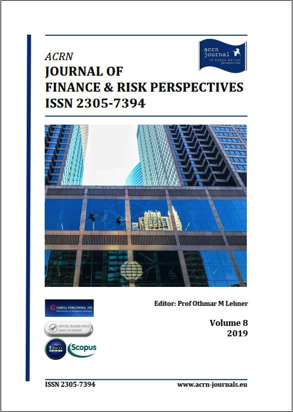ACRN Journal of Finance and Risk Perspectives
Vol. 6, Issue 2, ISSN 2305-7394

Sihem Khemakhem1, Younes Boujelbene2
1 University of Sfax, Faculty of Economics and Management of Sfax
2 University of Sfax, Faculty of Economics and Management of Sfax
Abstract: This work tries to determine the probability of default as a tool to measure credit risk in a Tunisian commercial bank. A scoring model was built according to the traditional technique of logistic regression (LR), and artificial intelligence techniques i.e. artificial neural networks (ANN) and support vector machines (SVM). Then a comparison was made between these models using performance metrics such as the confusion matrix and the area under the ROC curve (AUC) in order to identify the most efficient model. Our results show that the Radial Basis Function kernel SVM was the most performing method in terms of accuracy, sensitivity and specificity with the least error rates. Thus, in the Tunisia context, this model is worth implementing in banking institutions in order to improve their credit risk management measures to monitor and control credit.
Keywords: Credit risk; Support Vector Machines; Artificial Neural Network; Logistic Regression; Performance metrics
![]() Exploring Environmental Disclosure in Banks. Evidence from the Euro Area
Exploring Environmental Disclosure in Banks. Evidence from the Euro Area
Rosella Carè
Department of Legal, Historical, Economic and Social Sciences University Magna Graecia of Catanzaro, Italy
Abstract: Environmental issues are growing in importance over the years among scholars and practitioners. In particular, environmental considerations are becoming an important facet both in the sustainability engagement and communication process of the banks. Several key changes are occurring in the regulation and supervision of banking (and financial) systems and banks have come to realize that banking operations, in particular lending, affect and are affected by environment issues.
This work explore and compare the environmental disclosure of Global Systemically Important Banks (G-SIBs) headquartered in the Euro by analyzing environmental risk assessment and monitoring issue, through a multiple case study approach. The contribution of the work is twofold: on one hand, the research provides a better knowledge of the relationship between credit risk management process and environmental disclosure, and on the other hand it provides some thoughtful insights, give directions and encouragement for future research.
Keywords: Environmental Disclosure; Environmental Credit Risk Management; Case Studie
![]() Quantitative Description of Financial Transactions and Risks
Quantitative Description of Financial Transactions and Risks
Victor Olkhov
TVEL, Russia
Abstract: This paper presents a quantitative model of financial transactions between economic agents on economic space. Risk ratings of economic agents play role of their coordinates. Aggregate amounts of agent’s financial variables at point x define macro financial variables as functions of time and coordinates. Financial transactions between agents define evolution of agent’s financial variables. Aggregate amounts of financial transactions between agents at points x and y define macro financial transactions as functions of x and y. Macro transactions determine evolution of macro financial variables. To describe dynamics and interactions of macro transactions we derive hydrodynamic-like equations. Description of macro transactions permits model evolution of macro financial variables and hence develop dynamics and forecasts of macro finance. As example for simple model interactions between macro transactions we derive hydrodynamic-like equations and obtain wave equations for their perturbations. Waves of macro transactions induce waves of macro financial variables on economic space. Diversities of financial waves of macro transactions and macro financial variables on economic space in simple models uncover internal complexity of macro financial processes. Any developments of financial models and forecast should take into account financial wave processes and their influences.
Keywords: Macro Finance, Risk Ratings, Economic Space, Wave Equations
![]() Pricing Implications of Assessing Risk of Relative Wealth Outcomes
Pricing Implications of Assessing Risk of Relative Wealth Outcomes
Mohamed Ihab Kira
Department of Financial Management and Accounting Arab Academy for Science, Technology and Maritime Transport (Dokki Branch)
Abstract: When relative wealth is the variable used by agents to assess the risk of their financial future perfect coherence in the pricing of various types of financial assets ensues. The use of relative wealth instead of absolute wealth to analyze risk should not be construed as an assumption that agents do not care about absolute wealth. Relative wealth is a perfect substitute for absolute wealth in the case of certainty and on a state-of-nature by state-of-nature basis; however, the use of relative wealth to assess risk over the spectrum of states-of-nature reflects a different outlook about risk. The resulting pricing kernel and asset pricing model are reasonably robust to changes in utility functions and returns’ distributions. The excess return of an asset depends on the covariance of its return with the return on the market portfolio and on all their higher co-moments as well. The simple gross risk-free return equals the harmonic mean of the probability distribution of simple gross market returns; an implication that does not bode well for financial markets in the current prolonged environment of low interest rates. It is straightforward to show that options on basic securities are priced using the same model.
Keywords: asset pricing, relative wealth, risk-free rate, equilibrium, options